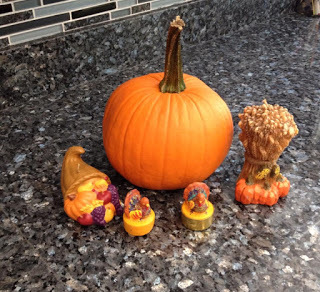Ann Lethbridge's Blog, page 2
January 12, 2017
Regency Fashion January 1817
Here is something that sounds new at least. The Witzchoura, originally from Poland, is a mantle or cloak, with wide sleeves and a huge collar.
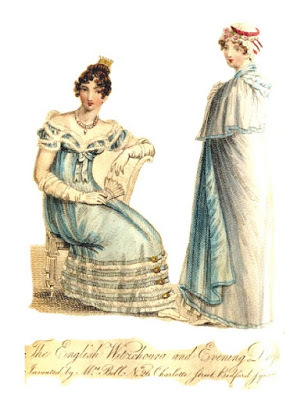 From the Lady’s Monthly Museum Mirror of Fashion
From the Lady’s Monthly Museum Mirror of FashionThe English Witzchoura
Is the greatest novelty and most useful appendage to dress for the present season that can be conceived: it protects the wearer from the inclemency of the weather, preserves the dress worn under from being rumpled, and forms a most elegant exterior covering, either for riding, walking or evening parties.
Its make is quite novel; of which our print conveys a perfect idea. It is composed of a superfine lilac and white mixture cloth, lined with silk. A lady’s chapeau bras is attached to the Witzchoura, made of the same material, and lined with silk, in a very novel manner.
The cornet cap is composed of blond lace and scarlet silk velvet, ornamented with flowers, producing a most rich and beautiful effect. Suitable gloves, boots, and shoes, are worn, as may be required.
Evening Dress.
Is made of a beautiful Paisley gauze, richly trimmed with white fur, and black cording all round the fur, so as to give a half-mourning appearance to the dress; which is of a moderate length, so as to shew a part of the instep; the sleeves are rather full, so as to give them a rich effect, falling gracefully over the shoulders, and somewhat exposing the bust and back.
White kid gloves, and white satin shoes.
I shall enjoy using this word in my books. Until next time
Published on January 12, 2017 09:00
January 9, 2017
Secrets of the Marriage Bed
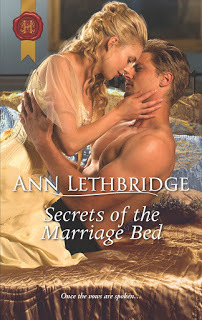 Out now
Out now After one night of passion, the dissolute Duke of Dunstan made Julia his wife, but their honeymoon is far from blissful. Alistair trusts no one with his shameful secret, and that means keeping his tempting new bride at a distance… Julia longs for Alistair to yield to the powerful desire between them. But when the dark secrets of the marriage bed threaten their future, this new couple must overcome the past and surrender to their wildest passions to find a new, oh-so-delicious beginning together!
Find out more at my website.
Published on January 09, 2017 12:26
December 28, 2016
HAPPY NEW YEAR MAY 2017 BE HEALTHY AND FULL OF JOY!!!!!!!
Published on December 28, 2016 06:53
December 20, 2016
Regency Fashion - December 1816
Interesting, but a little bland for my taste. What do you think?
Carriage Dress, 1816 Ackermann's
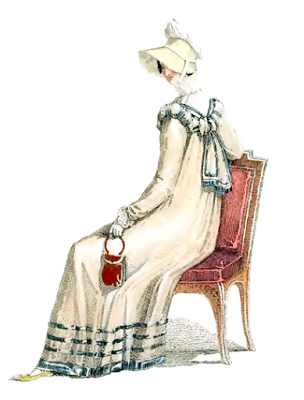 The description is as follows:
The description is as follows:
A gown of pale faun-colour cloth, made a walking length, and trimmed round the bottom with four rows of rich blue silk trimming. The body, which is cut very low, is ornamented in such a manner as to have a novel appearance, with a similar trimming, but very narrow.
The back, which is cut down on each side, is finished at the bottom of the waist by bows and long ends, trimmed to correspond.
A very tasteful half sleeve over a plain long sleeve, made tight at the wrist, and bound with blue trimming; it is finished by a narrow ruffle composed of three falls of tulle; fichu of tulle, with a ruff to correspond.
When worn as a carriage dress, the head-dress is a bonnet, the crown composed of white satin at top, and the middle and front of Leghorn; it is lined with white satin, and ornamented only by a white satin band and strings.
An India shawl is also indispensable to it as a carriage dress, for which hit is elegantly appropriate. Shoes and gloves of pale faun colour.
Our dresses this month are both French; but, as our readers will perceive from our prints, they are in the best style of Parisian costume. We have been favoured with them by a lady who has just returned from Paris.
Now I thought Leghorn was a style, here it is used to describe a material.
Until Next Time...............
Carriage Dress, 1816 Ackermann's
 The description is as follows:
The description is as follows:A gown of pale faun-colour cloth, made a walking length, and trimmed round the bottom with four rows of rich blue silk trimming. The body, which is cut very low, is ornamented in such a manner as to have a novel appearance, with a similar trimming, but very narrow.
The back, which is cut down on each side, is finished at the bottom of the waist by bows and long ends, trimmed to correspond.
A very tasteful half sleeve over a plain long sleeve, made tight at the wrist, and bound with blue trimming; it is finished by a narrow ruffle composed of three falls of tulle; fichu of tulle, with a ruff to correspond.
When worn as a carriage dress, the head-dress is a bonnet, the crown composed of white satin at top, and the middle and front of Leghorn; it is lined with white satin, and ornamented only by a white satin band and strings.
An India shawl is also indispensable to it as a carriage dress, for which hit is elegantly appropriate. Shoes and gloves of pale faun colour.
Our dresses this month are both French; but, as our readers will perceive from our prints, they are in the best style of Parisian costume. We have been favoured with them by a lady who has just returned from Paris.
Now I thought Leghorn was a style, here it is used to describe a material.
Until Next Time...............
Published on December 20, 2016 09:00
December 12, 2016
Regency Fashion
December 1816
Promenade Dress
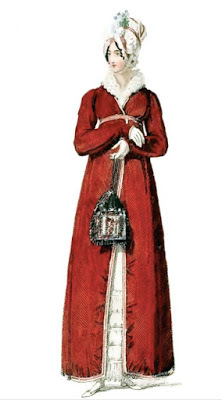 'Tis the Season.
'Tis the Season.
The richness of this gown in the December Ackermann's makes me think of Christmas and warmth.
Here is the description:
A HIGH dress of cambric muslin trimmed at the bottom with a single flounce of work.
The body, which is composed entirely of work, fits the shape without any fullness. A plain long sleeve, finished by a triple fall of narrow lace.
Over this dress is worn the Angouleme pelisse, composed of crimson velvet, lined with white sarsnet, and trimmed with a single welt of crimson satin, a shade lighter than the pelisse.
The body is made exactly to the shape; the back is of course a moderate breadth, and without fullness: for the form of the front we refer our readers to our print; it is confined at the waist, which is very short, by a narrow velvet band, edged to correspond. A small collar, of a novel and pretty shape, stands up and supports a rich lace ruff, which is worn open in front of the throat.
The sleeve has very little fullness, and that little is confined at the wrist by three narrow bands of puckered satin.
Bonnet a la Royale, composed of white satin very tastefully intermixed with a large bunch of fancy flowers, and tied under the chin by a white satin ribbon, which is brought in a bow to the left side; a full quilling of tulle finishes the front.
Black silk ridicule, exquisitely worked in imitation of the ends of an India shawl, and trimmed with black silk fringe. White kid gloves and black walking shoes.
I was intrigued by the ridicule, because of it's embroidery (described as work) and as you know that is my "thing". We see little of the dress itself, just a peek through the opening in the pelisse.
Until next time.....
Promenade Dress
 'Tis the Season.
'Tis the Season.The richness of this gown in the December Ackermann's makes me think of Christmas and warmth.
Here is the description:
A HIGH dress of cambric muslin trimmed at the bottom with a single flounce of work.
The body, which is composed entirely of work, fits the shape without any fullness. A plain long sleeve, finished by a triple fall of narrow lace.
Over this dress is worn the Angouleme pelisse, composed of crimson velvet, lined with white sarsnet, and trimmed with a single welt of crimson satin, a shade lighter than the pelisse.
The body is made exactly to the shape; the back is of course a moderate breadth, and without fullness: for the form of the front we refer our readers to our print; it is confined at the waist, which is very short, by a narrow velvet band, edged to correspond. A small collar, of a novel and pretty shape, stands up and supports a rich lace ruff, which is worn open in front of the throat.
The sleeve has very little fullness, and that little is confined at the wrist by three narrow bands of puckered satin.
Bonnet a la Royale, composed of white satin very tastefully intermixed with a large bunch of fancy flowers, and tied under the chin by a white satin ribbon, which is brought in a bow to the left side; a full quilling of tulle finishes the front.
Black silk ridicule, exquisitely worked in imitation of the ends of an India shawl, and trimmed with black silk fringe. White kid gloves and black walking shoes.
I was intrigued by the ridicule, because of it's embroidery (described as work) and as you know that is my "thing". We see little of the dress itself, just a peek through the opening in the pelisse.
Until next time.....
Published on December 12, 2016 09:32
December 1, 2016
Hall Place in Kent
Hall Place is perhaps one of the most unusual places we have been in search of the Regency. It is situated in Bexley in Kent. During the time I grew up theren the house was not open to the public, but it was a well-known local land mark.
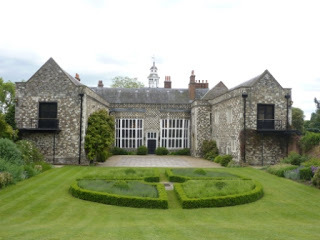 Hall place dates back to before Henry VIII's reformation and around that time fell into the hands of one of London's Lord Mayors, Sir John Champney a self-made man who died of the plague in 1556.
Hall place dates back to before Henry VIII's reformation and around that time fell into the hands of one of London's Lord Mayors, Sir John Champney a self-made man who died of the plague in 1556.
This is a view of the Tudor courtyard built for Champney with its stunning pattern of grey and white stone. A mark of his wealth and importance. Originally it would have had only one large oriel window looking into the courtyard, as all the other windows also would have done.
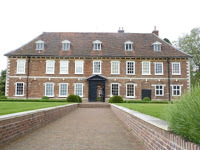 Over time, the house was added to and altered by succeeding owners and in 1772, the era in which we are interested it passed into the hands of Sir Francis Dashwood, later Baron Le Despenser. Apparently there really were Dashwoods around in Jane Austen's time.
Over time, the house was added to and altered by succeeding owners and in 1772, the era in which we are interested it passed into the hands of Sir Francis Dashwood, later Baron Le Despenser. Apparently there really were Dashwoods around in Jane Austen's time.
The red brick extension, with its two wings and front facing outwards now, was added to what would have been the back of Tudor buildings as seen here. The extension formed a central enclosed courtyard between the new front and the old tudor great hall, and provided a corridor between the wings.
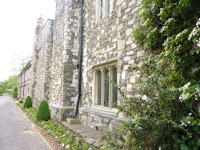 A view along the side shows where the new was added to the old. I must say I found it rather odd from this angle, but I cannot contain my respect for those who decided to keep the old Tudor part in tact.
A view along the side shows where the new was added to the old. I must say I found it rather odd from this angle, but I cannot contain my respect for those who decided to keep the old Tudor part in tact.
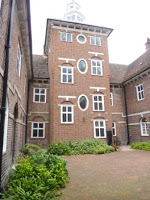
A bell tower was added within the new courtyard with a fashionable prospect room at the top for watching the hunt and for entertaining. What and interesting looking tower it is. The rectangular windows follow the ascending stairs to form an unusual asymmetric pattern. The courtyard at this time would have been the hub of the household. Water was fetched from the pump and arrivals and departures would be observed from the upstairs windows. The archways around the courtyard lead to the new architectural development --- corridors. It enabled privacy, one room no longer leading directly into the next
At the time Sir Francis inherited the property it was rented out to a Richard Calvert Esquire and then to the Reverend Richard Jeffreys in 1798 who set it up as a School for young gentlemen. And so it remained until the 1860's.
What a wonderful place for boys to go to school. At the time there were coach houses, stables, outhouses, office buildings, boat yards, orchard gardens, shrubberies, a pleasure ground and appurtenances thereto.
What a great setting for a story.
Hall Place today is a mix of original Tudor, Commonwealth and Restoration.
Next time will will take a peek around the interior. Until then.....
I
 Hall place dates back to before Henry VIII's reformation and around that time fell into the hands of one of London's Lord Mayors, Sir John Champney a self-made man who died of the plague in 1556.
Hall place dates back to before Henry VIII's reformation and around that time fell into the hands of one of London's Lord Mayors, Sir John Champney a self-made man who died of the plague in 1556.This is a view of the Tudor courtyard built for Champney with its stunning pattern of grey and white stone. A mark of his wealth and importance. Originally it would have had only one large oriel window looking into the courtyard, as all the other windows also would have done.
 Over time, the house was added to and altered by succeeding owners and in 1772, the era in which we are interested it passed into the hands of Sir Francis Dashwood, later Baron Le Despenser. Apparently there really were Dashwoods around in Jane Austen's time.
Over time, the house was added to and altered by succeeding owners and in 1772, the era in which we are interested it passed into the hands of Sir Francis Dashwood, later Baron Le Despenser. Apparently there really were Dashwoods around in Jane Austen's time.The red brick extension, with its two wings and front facing outwards now, was added to what would have been the back of Tudor buildings as seen here. The extension formed a central enclosed courtyard between the new front and the old tudor great hall, and provided a corridor between the wings.
 A view along the side shows where the new was added to the old. I must say I found it rather odd from this angle, but I cannot contain my respect for those who decided to keep the old Tudor part in tact.
A view along the side shows where the new was added to the old. I must say I found it rather odd from this angle, but I cannot contain my respect for those who decided to keep the old Tudor part in tact.
A bell tower was added within the new courtyard with a fashionable prospect room at the top for watching the hunt and for entertaining. What and interesting looking tower it is. The rectangular windows follow the ascending stairs to form an unusual asymmetric pattern. The courtyard at this time would have been the hub of the household. Water was fetched from the pump and arrivals and departures would be observed from the upstairs windows. The archways around the courtyard lead to the new architectural development --- corridors. It enabled privacy, one room no longer leading directly into the next
At the time Sir Francis inherited the property it was rented out to a Richard Calvert Esquire and then to the Reverend Richard Jeffreys in 1798 who set it up as a School for young gentlemen. And so it remained until the 1860's.
What a wonderful place for boys to go to school. At the time there were coach houses, stables, outhouses, office buildings, boat yards, orchard gardens, shrubberies, a pleasure ground and appurtenances thereto.
What a great setting for a story.
Hall Place today is a mix of original Tudor, Commonwealth and Restoration.
Next time will will take a peek around the interior. Until then.....
I
Published on December 01, 2016 09:00
November 28, 2016
Fashion for November 1816
The weather is cooling down but the fashions are hotting up.
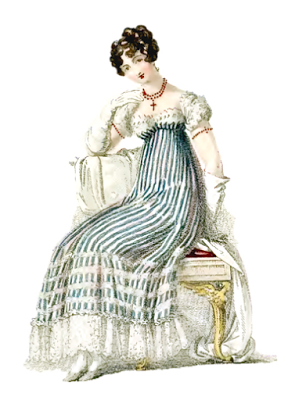
What could be more Regency than this striped gown?
From Ackermann's November 1816
Evening Dress
A lilac and white striped gauze dress over a white satin slip; the bottom of the skirt is ornamented with five rows of white silk trimming of a very light and elegant description: it has just been introduced, and the pattern has more novelty than any thing we have seen for some time: a single flounce of deep blond lace completes the trimming.
The body is also very novel; the upper part is formed of lace, and the lower of gauze, to correspond with the dress: the latter is quite tight to the shape, but the former has an easy fullness, which forms the shape in a manner extremely advantageous to the figure.
The sleeve is short and very full; it is composed of lace, looped high, and finished by a trimming to correspond with that on the skirt.
The hair is full dressed, without any ornament.
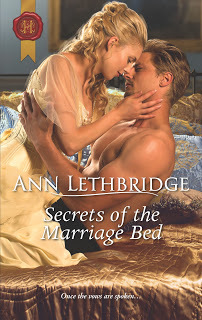 Necklace, cross, armlets and bracelets of rubies. White satin slippers, and white kid gloves.
Necklace, cross, armlets and bracelets of rubies. White satin slippers, and white kid gloves.I like this gown, very pretty and flattering. Get out your rubies, ladies!
Don't forget to order your copy of Secrets of the Marriage Bed in on-line stores everywhere. Go to my website for links
What woman doesn't need to know a few secrets?
Published on November 28, 2016 07:03
November 24, 2016
Happy Thanksgiving
Published on November 24, 2016 10:57
November 17, 2016
Fawkham in Kent
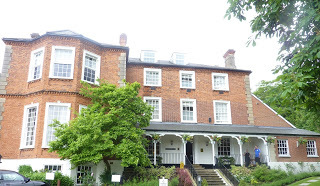 Fawkham Green in Kent or Fawkham is not likely a place you have ever heard of. Indeed, in 17 97 it was described thusly:
Fawkham Green in Kent or Fawkham is not likely a place you have ever heard of. Indeed, in 17 97 it was described thusly:THIS PARISH is a lonely unfrequented place, and contains about one thousand acres of land, of which about two hundred and fifty are wood, having no public high road through it. It lies on high ground, among the hills; the soil is much inclined to chalk, and is very slinty and barren, but though it is poor, yet this, as well as the neighbouring parishes in a like situation, is in some measure recompensed by being exceedingly healthy. There are two hamlets in it called Fawkham-green and Fawkham-street. The church stands near the northern boundary of it. The seat of Pennis is situated in the middle of the parish, adjoining to a large wood, which extends quite across it.
For all that, or perhaps because of it, the Duke of Norfolk built a country home here in 1806. Now the Brands Hatch hotel, it is a beautiful Georgian Manor and a lovely place to stay. The red brick mansion comes into view at the end of a tree-lined drive and visitors may enjoy twelve acres of surround gardens and parklandm
I have to admit it is not as quiet as it would have been in the Duke of Norfolk's day as one can easily hear the sound of engines buzzing from the nearby racetrack. But the grounds are quite lovely, the room elegantly appointed and the dining excellent.
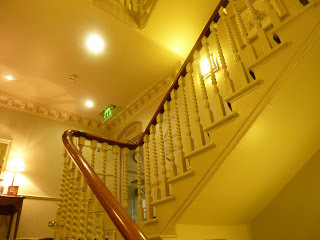
More enticing yet were the glimpses of the Regency still visible inside and outside.
This staircase for example, and the exterior above.
If you like to stay where history meets modern conveniences, this might well be the place for you.
Join me next time as I delve deeper into Kent,
Until then.......
Published on November 17, 2016 08:15
Fawham in Kent
 Fawkham Green in Kent or Fawkham is not likely a place you have ever heard of. Indeed, in 17 97 it was described thusly:
Fawkham Green in Kent or Fawkham is not likely a place you have ever heard of. Indeed, in 17 97 it was described thusly:THIS PARISH is a lonely unfrequented place, and contains about one thousand acres of land, of which about two hundred and fifty are wood, having no public high road through it. It lies on high ground, among the hills; the soil is much inclined to chalk, and is very slinty and barren, but though it is poor, yet this, as well as the neighbouring parishes in a like situation, is in some measure recompensed by being exceedingly healthy. There are two hamlets in it called Fawkham-green and Fawkham-street. The church stands near the northern boundary of it. The seat of Pennis is situated in the middle of the parish, adjoining to a large wood, which extends quite across it.
For all that, or perhaps because of it, the Duke of Norfolk built a country home here in 1806. Now the Brands Hatch hotel, it is a beautiful Georgian Manor and a lovely place to stay. The red brick mansion comes into view at the end of a tree-lined drive and visitors may enjoy twelve acres of surround gardens and parklandm
I have to admit it is not as quiet as it would have been in the Duke of Norfolk's day as one can easily hear the sound of engines buzzing from the nearby racetrack. But the grounds are quite lovely, the room elegantly appointed and the dining excellent.

More enticing yet were the glimpses of the Regency still visible inside and outside.
This staircase for example, and the exterior above.
If you like to stay where history meets modern conveniences, this might well be the place for you.
Join me next time as I delve deeper into Kent,
Until then.......
Published on November 17, 2016 08:15


